无线通信外文翻译
- 格式:doc
- 大小:30.00 KB
- 文档页数:9
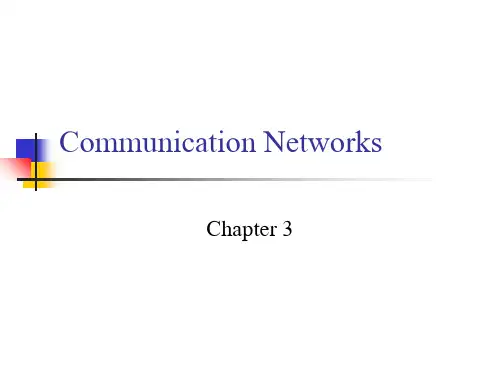
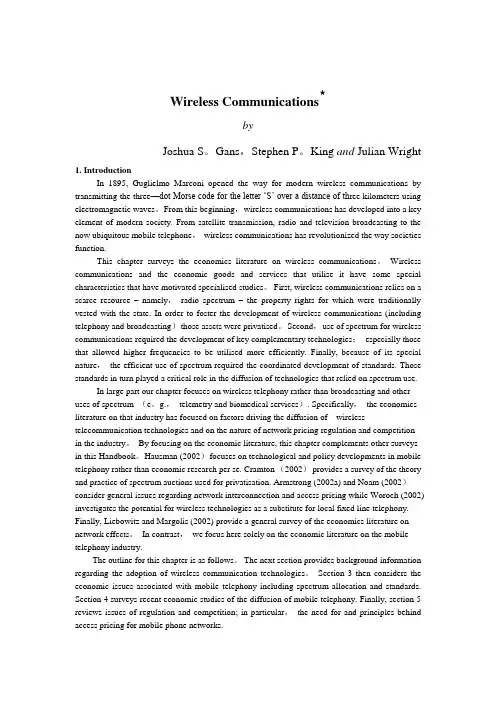
Wireless Communications*byJoshua S。
Gans,Stephen P。
King and Julian Wright1. IntroductionIn 1895, Guglielmo Marconi opened the way for modern wireless communications by transmitting the three—dot Morse code for the letter ‘S’ over a distance of th ree kilometers using electromagnetic waves。
From this beginning,wireless communications has developed into a key element of modern society. From satellite transmission, radio and television broadcasting to the now ubiquitous mobile telephone,wireless communications has revolutionized the way societies function.This chapter surveys the economics literature on wireless communications。
Wireless communications and the economic goods and services that utilise it have some special characteristics that have motivated specialised studies。
First, wireless communications relies on a scarce resource –namely,radio spectrum –the property rights for which were traditionally vested with the state. In order to foster the development of wireless communications (including telephony and broadcasting)those assets were privatised。

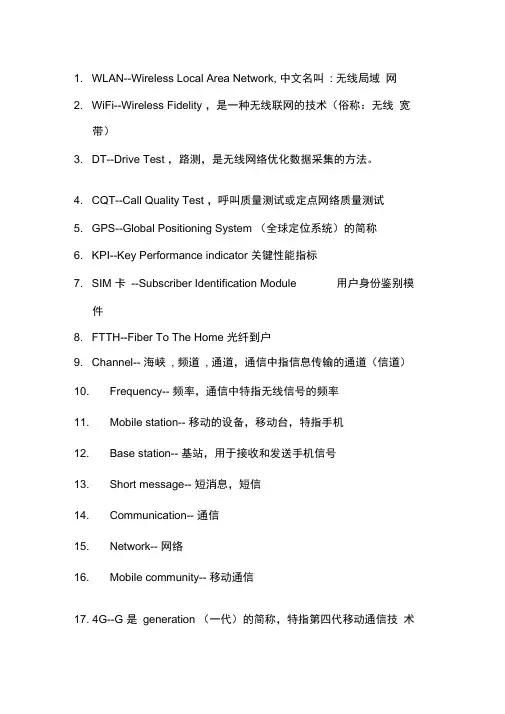
1. WLAN--Wireless Local Area Network, 中文名叫: 无线局域网2. WiFi--Wireless Fidelity ,是一种无线联网的技术(俗称:无线宽带)3. DT--Drive Test ,路测,是无线网络优化数据采集的方法。
4. CQT--Call Quality Test ,呼叫质量测试或定点网络质量测试5. GPS--Global Positioning System (全球定位系统)的简称6. KPI--Key Performance indicator 关键性能指标7. SIM 卡--Subscriber Identification Module 用户身份鉴别模件8. FTTH--Fiber To The Home 光纤到户9. Channel-- 海峡, 频道, 通道,通信中指信息传输的通道(信道)10. Frequency-- 频率,通信中特指无线信号的频率11. Mobile station-- 移动的设备,移动台,特指手机12. Base station-- 基站,用于接收和发送手机信号13. Short message-- 短消息,短信14. Communication-- 通信15. Network-- 网络16. Mobile community-- 移动通信17. 4G--G 是generation (一代)的简称,特指第四代移动通信技术18. Protocol-- 协议,网络之间互联遵循的规范Online--在线的,名词可指网游 On li ne bankin g--网上银行 Wireless--无线,通信领域范畴指的是无线电或无线电波 Broadcast--广播Cell--细胞;电池;蜂房的巢室;单人小室。
移动通信网络中 特指小区(基站信号覆盖的范围) Satellite Com mun icatio n-- 卫星通信Ch ina Mobile--中国移动 China Telecom--中国电信 China Unicom--中国联通 Opted fiber-- 光纤 Cable--电缆Man ageme nt--管理 DC--direct curre nt ,直流电AC--alternati ng curre nt,交流电 DT--Drive Test ,无线网络路测 CQT--Call Quality Test ,呼叫质量测试(通信里常称为拨打 测试) 19.20.21.22.23. 24.25.26.27.28.29.30.31.32.33.34. 35.36.37.38.Accepta nee of work-- 工程验收Project startup -- 工程启动Prelimi nary in specti on-- 初验Con structi on quality-- 工程质量39. Project acco un ti ng-- 项目核算40. Engin eeri ng supervisi on-- 工程督导41. Project ma nager-- 项目经理42. Project engin eer--项目工程师43. Project completio n-- 项目竣工44. Un pack ing in specti on-- 开箱验货45. Time limit for a project-- 工期46. 抽样量化与编码:sampling,quantizing and coding47. 话路:speech channel 幅值:amplitude value48. 抽样频率:sampling frequency49. 抽样速率:sampling rate 脉冲流:stream of pulses50. 重复率:repetition rate 编码过程:coding process51. 模拟信号:analog signal52. 传输质量:transmission quality53. 数字通信:digital communication54. 数字传输:digital transmission55. 含噪声的环境:noisy environment56. 传输路由:transmission path57 信噪比:signal-to-noise ratio58.信号电平:signal levels 噪声功率:noise power59地面系统:terrestrial system60. 二进制传输:binary tra nsmissi on61. 反向操作:reverse operati on62.8-位码序列:8-digit sequenee63. 接受端:receiving termi nal 帧格式:frame format64. 同步字:synchronization word65. 串行接口serial in terface显示终端CRT term in al发送器与接收器tra nsmitter and receiver数据传输data tran smissi on数据流data stream闲置状态the idle state传号电平mark level空号电位space level起始位start bit停止位stop bitT 秒的持续时间durati on of T seco nds奇偶校检位parity bit错误标志error flag 传输错误tra nsmissi on error下降沿fallinf edge 符号间的空格in tersymbol space接收机的定时receiver timi ng 本地时钟local clock 磁带magnetic tape 控制比特con trol bit 逻辑1 电平logical 1 level二进制数据binary data通信卫星commu ni cati on satellite微波设备microwave facilities 调制器与解调器modulator and demodulator缓冲器buffer定时信号timi ng sig nals同步脉冲syn chr oni zati on pulses时隙time slot移位寄存器shift register传输媒体tra nsmissi on medium线形衰弱lin ear atte nuati on信息安全in formati on security键盘keyboard数据终端data termi nals网络资源:n etwork resource信息服务:in formatio n services远程终端:remote termi nals互联的系统:interconn ected systems命令:comma nd电子邮件:electro nic mail主机:host无线信道:wireless cha nnels搜索工具:search ing tools用户界面:user in terface存取:access文本信息:textual messages协议:protocol超文本协议:hypertext protocolthe 分布在全世界的计算机的巨大网络:gaint network of computers located all overworld主干系统:backb one system全国范围的网络:n atio nwild network电子会议:electro nic con fere nces实时对话:live con versati on最大的信息库the largest repository of the computers on the net 网络设备资源:n etwork facilities resources在网上的绝大多数计算机:the vast majority of the computer on the netUNIX 操作系统:the UNIX operating system在因特网和你的PC机之间传送数据的方法: a way to move data between theand your PC方便的搜索工具:the convenient search ing tools联网的超文本协议:the :n etwork hypertextprotoco l光纤通信:optical fiber commu ni cati ons光源:light source波长:wavele ngth激光器:laser色散:dispersi on传输介质:tran smissi on medium多模光纤:multi-mode fiber长途干线:lon g-houl trunks单模光纤:sin ger-mode fiber带宽:ban dwidth带宽用户:wideba nd subscriber纤维光学:fiber-optics商用技术:commercial tech no loge门限电流:threshod curre nt光检测器:photodetector波分复用:wavele ngth multiplex ing纤维光网络:fiber-optic network视频带宽:video ban dwidth长途传输:long dista nee tra nsmissi on中继距离:repeater spac ing已装光纤的总长度:the total len gth of in stalled fiber 长途通信系统:lon g-haul telecommu nicatio nsystem低衰减的石英纤维:the low-loss silica fiber波分复用:wavele ngth multiplexi ng带宽用户环路系统:widebe nd subscriber loop system多纤连接器:multifibre conn ectors设计寿命:projected lifetime光源:light source单模光纤:sin gle-mode fibre分布反馈式激光器:distributed-feedback laser信息容量:in formatio n capacity交换体系:switch ing hierarchy带宽业务:broadband services公用电信网public telecommu nicatio n n etwork本地环路local loop交换节点switching 1 nodeinternet双绞线 twisted pair外部呼叫 externalcall 二线连接 two wire connection收费中心 toll cen ter电路交换网 circuit-switch ing n etwork电话用户 telepho ne subscriber数据流量 data traffic链路 link中继线 trunk半双工的 half-duplex全双工的 full-duplex中间交换节点 in termediate switchi ng node音频电路voice-freque ncy circuit汇接交换机 tan dem switch拓扑 topology多媒体 multimedia交互环境in teractive en vior nment视频压缩 video compress in高清晰度电视 high defi ni tio n televisi on数字信号处理器 digital sig nal processor点播业务 on-dema nd services视频服务器 video servers全球通信 global commu ni cati ons灵活性 flexibility端到端的数字连接 en d-to-e nd digital conn ectivity开放网络 ope n n etwork语声编码voice en cod ing综合业务数字网 in tegrated services digital n etwork系统结构 in frastructure国际标准化组织 Intern ati onal Organi zati on for Stan dardizati on 通信载体 commu ni cati on carriers传输媒体 tran smissi on medium接口设备 in terface equipme nt带宽限制 ban dwidth limitati on 交换设备 switchi ng equipme nt语音编码 voice en cod ing脉码调制 pulse code modulati on基本接入 basic accessX.25协议 X.25 protocol电视信号 televisi on sig nals 宽带业务 n arrowba nd services基本接入 basic access端局 数字数据系统 digital data systemsend officeteleservicetelexradio waves grou nd antenna coaxial直接广播系统 direct broadcast systemvideo-on-dema nd in teractive services 交互式视频点播业务multimedia en virome nt 多媒体环境 visual images 视频图象hard disk storage 硬盘存储colour mon itor 彩显the standards of multimedia 多媒体标准 moti on pictures 活动图象consumer quality of video and audio 顾客质量的视频和音频 broadcast images 广播图象high defin ition televisi on 高清晰度电视 cod ing algorithms 编码算法digital sig nals processor 数字信号处理器 端到端的时延 en d-to-e nd delay抖动 繁忙小时 芯片技术 高清晰度电视 运行也维护 jitterpeak hourschip tech no logyhigh defi niti on televisi on operations and maintenance 现有的公用网络 the exist ing public 硬件、软件和应用 hardware,software 存储 storage n etwork and applicati ons 彩显 colour mon iter全活动图象 full motion picture视频编码器 visio n en coder字节 bytemixture of hardware,software and applicatio ns 硬件、软件和应用层 in teractive en vir onment 交互环境personal desk top computers video compressi on 视频压缩the vision encoder 视频编码器个人桌面电脑 电信业务 用户电报 无线电波 地面天线 同轴的。

1. WLAN--Wireless Local Area Network, 中文名叫: 无线局域网2. WiFi--Wireless Fidelity ,是一种无线联网的技术(俗称:无线宽带)3. DT--Drive Test ,路测,是无线网络优化数据采集的方法。
4. CQT--Call Quality Test ,呼叫质量测试或定点网络质量测试5. GPS--Global Positioning System (全球定位系统)的简称6. KPI--Key Performance indicator 关键性能指标7. SIM 卡--Subscriber Identification Module 用户身份鉴别模件8. FTTH--Fiber To The Home 光纤到户9. Channel-- 海峡, 频道, 通道,通信中指信息传输的通道(信道)10. Frequency-- 频率,通信中特指无线信号的频率11. Mobile station-- 移动的设备,移动台,特指手机12. Base station-- 基站,用于接收和发送手机信号13. Short message-- 短消息,短信14. Communication-- 通信15. Network-- 网络16. Mobile community-- 移动通信17. 4G--G 是generation (一代)的简称,特指第四代移动通信技术18. Protocol-- 协议,网络之间互联遵循的规范Online--在线的,名词可指网游 On li ne bankin g--网上银行 Wireless--无线,通信领域范畴指的是无线电或无线电波 Broadcast--广播Cell--细胞;电池;蜂房的巢室;单人小室。
移动通信网络中 特指小区(基站信号覆盖的范围) Satellite Com mun icatio n-- 卫星通信Ch ina Mobile--中国移动 China Telecom--中国电信 China Unicom--中国联通 Opted fiber-- 光纤 Cable--电缆Man ageme nt--管理 DC--direct curre nt ,直流电AC--alternati ng curre nt,交流电 DT--Drive Test ,无线网络路测 CQT--Call Quality Test ,呼叫质量测试(通信里常称为拨打 测试) 19.20.21.22.23. 24.25.26.27.28.29.30.31.32.33.34. 35.36.37.38.Accepta nee of work-- 工程验收Project startup -- 工程启动Prelimi nary in specti on-- 初验Con structi on quality-- 工程质量39. Project acco un ti ng-- 项目核算40. Engin eeri ng supervisi on-- 工程督导41. Project ma nager-- 项目经理42. Project engin eer--项目工程师43. Project completio n-- 项目竣工44. Un pack ing in specti on-- 开箱验货45. Time limit for a project-- 工期46. 抽样量化与编码:sampling,quantizing and coding47. 话路:speech channel 幅值:amplitude value48. 抽样频率:sampling frequency49. 抽样速率:sampling rate 脉冲流:stream of pulses50. 重复率:repetition rate 编码过程:coding process51. 模拟信号:analog signal52. 传输质量:transmission quality53. 数字通信:digital communication54. 数字传输:digital transmission55. 含噪声的环境:noisy environment56. 传输路由:transmission path57 信噪比:signal-to-noise ratio58.信号电平:signal levels 噪声功率:noise power59地面系统:terrestrial system60. 二进制传输:binary tra nsmissi on61. 反向操作:reverse operati on62.8-位码序列:8-digit sequenee63. 接受端:receiving termi nal 帧格式:frame format64. 同步字:synchronization word65. 串行接口serial in terface显示终端CRT term in al发送器与接收器tra nsmitter and receiver数据传输data tran smissi on数据流data stream闲置状态the idle state传号电平mark level空号电位space level起始位start bit停止位stop bitT 秒的持续时间durati on of T seco nds奇偶校检位parity bit错误标志error flag 传输错误tra nsmissi on error下降沿fallinf edge 符号间的空格in tersymbol space接收机的定时receiver timi ng 本地时钟local clock 磁带magnetic tape 控制比特con trol bit 逻辑1 电平logical 1 level二进制数据binary data通信卫星commu ni cati on satellite微波设备microwave facilities 调制器与解调器modulator and demodulator缓冲器buffer定时信号timi ng sig nals同步脉冲syn chr oni zati on pulses时隙time slot移位寄存器shift register传输媒体tra nsmissi on medium线形衰弱lin ear atte nuati on信息安全in formati on security键盘keyboard数据终端data termi nals网络资源:n etwork resource信息服务:in formatio n services远程终端:remote termi nals互联的系统:interconn ected systems命令:comma nd电子邮件:electro nic mail主机:host无线信道:wireless cha nnels搜索工具:search ing tools用户界面:user in terface存取:access文本信息:textual messages协议:protocol超文本协议:hypertext protocolthe 分布在全世界的计算机的巨大网络:gaint network of computers located all overworld主干系统:backb one system全国范围的网络:n atio nwild network电子会议:electro nic con fere nces实时对话:live con versati on最大的信息库the largest repository of the computers on the net 网络设备资源:n etwork facilities resources在网上的绝大多数计算机:the vast majority of the computer on the netUNIX 操作系统:the UNIX operating system在因特网和你的PC机之间传送数据的方法: a way to move data between theand your PC方便的搜索工具:the convenient search ing tools联网的超文本协议:the :n etwork hypertextprotoco l光纤通信:optical fiber commu ni cati ons光源:light source波长:wavele ngth激光器:laser色散:dispersi on传输介质:tran smissi on medium多模光纤:multi-mode fiber长途干线:lon g-houl trunks单模光纤:sin ger-mode fiber带宽:ban dwidth带宽用户:wideba nd subscriber纤维光学:fiber-optics商用技术:commercial tech no loge门限电流:threshod curre nt光检测器:photodetector波分复用:wavele ngth multiplex ing纤维光网络:fiber-optic network视频带宽:video ban dwidth长途传输:long dista nee tra nsmissi on中继距离:repeater spac ing已装光纤的总长度:the total len gth of in stalled fiber 长途通信系统:lon g-haul telecommu nicatio nsystem低衰减的石英纤维:the low-loss silica fiber波分复用:wavele ngth multiplexi ng带宽用户环路系统:widebe nd subscriber loop system多纤连接器:multifibre conn ectors设计寿命:projected lifetime光源:light source单模光纤:sin gle-mode fibre分布反馈式激光器:distributed-feedback laser信息容量:in formatio n capacity交换体系:switch ing hierarchy带宽业务:broadband services公用电信网public telecommu nicatio n n etwork本地环路local loop交换节点switching 1 nodeinternet双绞线 twisted pair外部呼叫 externalcall 二线连接 two wire connection收费中心 toll cen ter电路交换网 circuit-switch ing n etwork电话用户 telepho ne subscriber数据流量 data traffic链路 link中继线 trunk半双工的 half-duplex全双工的 full-duplex中间交换节点 in termediate switchi ng node音频电路voice-freque ncy circuit汇接交换机 tan dem switch拓扑 topology多媒体 multimedia交互环境in teractive en vior nment视频压缩 video compress in高清晰度电视 high defi ni tio n televisi on数字信号处理器 digital sig nal processor点播业务 on-dema nd services视频服务器 video servers全球通信 global commu ni cati ons灵活性 flexibility端到端的数字连接 en d-to-e nd digital conn ectivity开放网络 ope n n etwork语声编码voice en cod ing综合业务数字网 in tegrated services digital n etwork系统结构 in frastructure国际标准化组织 Intern ati onal Organi zati on for Stan dardizati on 通信载体 commu ni cati on carriers传输媒体 tran smissi on medium接口设备 in terface equipme nt带宽限制 ban dwidth limitati on 交换设备 switchi ng equipme nt语音编码 voice en cod ing脉码调制 pulse code modulati on基本接入 basic accessX.25协议 X.25 protocol电视信号 televisi on sig nals 宽带业务 n arrowba nd services基本接入 basic access端局 数字数据系统 digital data systemsend officeteleservicetelexradio waves grou nd antenna coaxial直接广播系统 direct broadcast systemvideo-on-dema nd in teractive services 交互式视频点播业务multimedia en virome nt 多媒体环境 visual images 视频图象hard disk storage 硬盘存储colour mon itor 彩显the standards of multimedia 多媒体标准 moti on pictures 活动图象consumer quality of video and audio 顾客质量的视频和音频 broadcast images 广播图象high defin ition televisi on 高清晰度电视 cod ing algorithms 编码算法digital sig nals processor 数字信号处理器 端到端的时延 en d-to-e nd delay抖动 繁忙小时 芯片技术 高清晰度电视 运行也维护 jitterpeak hourschip tech no logyhigh defi niti on televisi on operations and maintenance 现有的公用网络 the exist ing public 硬件、软件和应用 hardware,software 存储 storage n etwork and applicati ons 彩显 colour mon iter全活动图象 full motion picture视频编码器 visio n en coder字节 bytemixture of hardware,software and applicatio ns 硬件、软件和应用层 in teractive en vir onment 交互环境personal desk top computers video compressi on 视频压缩the vision encoder 视频编码器个人桌面电脑 电信业务 用户电报 无线电波 地面天线 同轴的。
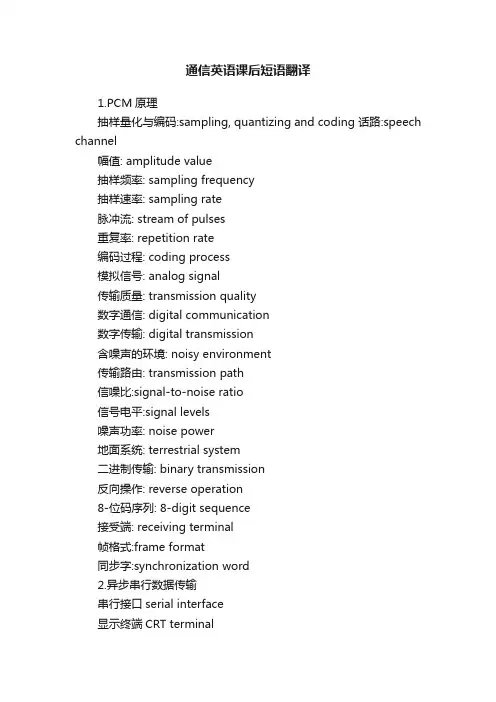
通信英语课后短语翻译1.PCM原理抽样量化与编码:sampling, quantizing and coding 话路:speech channel幅值: amplitude value抽样频率: sampling frequency抽样速率: sampling rate脉冲流: stream of pulses重复率: repetition rate编码过程: coding process模拟信号: analog signal传输质量: transmission quality数字通信: digital communication数字传输: digital transmission含噪声的环境: noisy environment传输路由: transmission path信噪比:signal-to-noise ratio信号电平:signal levels噪声功率: noise power地面系统: terrestrial system二进制传输: binary transmission反向操作: reverse operation8-位码序列: 8-digit sequence接受端: receiving terminal帧格式:frame format同步字:synchronization word2.异步串行数据传输串行接口serial interface显示终端CRT terminal发送器与接收器transmitter and receiver数据传输data transmission数据流data stream闲置状态the idle state传号电平mark level空号电位space level起始位start bit停止位stop bitT秒的持续时间duration of T seconds奇偶校检位parity bit错误标志error flag传输错误transmission error下降沿falling edge符号间的空格intersymbol space接收机的定时receiver timing本地时钟local clock磁带magnetic tape控制比特control bit逻辑1电平logical 1 level二进制数据binary data明显的缺点obvious disadvantage3.ISO联网标准联网技术networking technology国际标准化组织the international organization for standardization 参考模型reference model数据分组data pakects应用程序application program网络媒体network media分层layering硬件和软件hardware and software表示层the presentation layer传输层the transport layer数据链路层the data link layer网络服务network services文件接入file-access数据格式the data format主机host协议protocol连接connectivity逻辑选址logical addressing4.互联网网络资源:network resource信息服务:information services远程终端:remote terminals互联的系统:interconnected systems 命令:command电子邮件:electronic mail主机:host无线信道:wireless channels搜索工具:searching tools用户界面:user interface存取:access文本信息:textual messages协议:protocol超文本协议:hypertext protocol5.光纤通信介绍光纤通信:optical fiber communications 光源:light source波长:wavelength激光器:laser色散:dispersion传输介质:transmission medium多模光纤:multi-mode fiber长途干线:long-haul trunks单模光纤:singer-mode fiber带宽:bandwidth带宽用户:wideband subscriber纤维光学:fiber-optics商用技术:commercial technology门限电流:threshold current光检测器:photodetector波分复用:wavelength multiplexing纤维光网络:fiber-optic network视频带宽:video bandwidth6.同步数字系列同步数字系统:synchronous digital hierarchy 国际标准:international standard信号格式:signal format网络节点接口:network node interface支路信号:tributary signals数字交叉连接:digital cross-connection网络管理:network management网络维护:network maintenance网络运营者:network operators传输速率:transmission rate支路映射:tributary mapping灵活性:flexibility用户业务:subscriber services覆盖层:overlay levels制造商:manufacturer同步传输帧:synchronous transmission frame线路终端复用器:line terminal multiplexer分插复用器:add-drop multiplexer再生中继器:regenerator灵敏度:sensitivity虚容器:virtual container成帧字节:framing bytes段开销:section overhead端到端传输:end-to-end transmission误码监视:error monitoring信号处理节点:signal processing nodes净负荷:payload指针:pointer7.波分复用对光特性的理解:the understanding of the property of light 基本重要性:the fundamental important想象今天的通信系统:to imagine the communication system of today 光的高速公路:the highway of light巨量的信息:the massive amount of information采用通信新技术:to adopt new communication technology 大量的视频信息:the large amounts of video information波分复用:the wave divide multiplexing只发送单个波长:to send only one wavelength传输大量的波长:to transmit a large amount of wavelength 无差错传输:the error-free transmission自愈特性:the self-healing properties直接接入光网络:to access directly to the optical network视频信息:the video information8.蜂窝式移动电话系统蜂窝式移动电话:cellular mobile telephone服务性能:services performance频谱:frequency spectrum频带:frequency band微处理器:microprocessor移动手机:mobile unit广播业务:broadcast service天线:antenna子系统:subsystems移动用户:mobile subscriber服务能力:service capability利用率:utilization带宽:bandwidth单边带:single-sideband扩频:spread spectrum大规模集成电路:large scale integrated circuits 蜂窝点:cellular site蜂窝交换机:cellular switch无线机架:radio cabinet呼叫处理:call processing9.全球移动通信系统个人通信personal communication通信标准communication standards固定电话业务fixed telephone services网络容量network capability移动交换中心mobile switching center国际漫游international roaming宽带业务broadband services接口转换interface conversion频谱分配frequency allocation模拟方式analogue mode蜂窝通信原理cellular communication principle拥塞jamming蜂窝裂变cellular splitting基站base station寄存器register收费功能billing function接入方法access method突发脉冲传输方式bursty transmission mode开销信息overhead information切换算法handover algorithms短消息服务short message services技术规范technical specification10.3G移动电话the mobile telephone第三代移动业务the third generation mobile service 互联协议the Internet Protocol无线通信the wireless communication手机the handset全球漫游the global roaming无线标准the wireless standard蜂窝点the cell site峰值数据速率the peak data rate平均吞吐量the average throughput下载the download多址接入the multiple access扩频技术the spread spectrum technology时隙the timeslot11.电路交换和分组交换电路交换circuit switching分组交换packet switching报文交换message switching子网subnet信头header目的地址destination address误差控制error control存储转发方式store-and-forward manner突发性bursty传输时延transmission delay中间交换设备intermediate switching equipment 交换技术switching technique返回信号return signal报文处理机message processor给定最大长度given maximum length信息转移information transfer随机性random专用电路dedicated circuit电路利用率channel utilization12.A TM异步转移模式异步转移模式asynchronous逻辑信道logical channel虚电路virtual circuits虚路径virtual paths建议recommendation网络层network level业务与应用层service and application虚连接virtual connection信息高速公路information superhighway 点播电视video-on-demand统计复用statistical multiplexing数字化的信息digital information标识符identifier协议protocols网络节点network node宽带网broadband networkATM论坛ATM forum面向未来future-proofed图象编码image encoding虚拟专用网virtual private network数据处理data processing17.NGN信息技术the information technology数据包the data package电信行业the telecommuniccation industry 固定网业务tge fixed-network services网络运营商the network operaters接入技术the access technology核心网the coer network互联协议the internet protocol基于分组的网络the packet-based network 业务提供商the service provider管理层the management level网关the gateway传输平台the transport platform路由器the router交换机the switch增值业务the value-added services千兆字节the gigabyte无线连the wireless connection可编程器件the programmable devices媒体网关the media gateway。
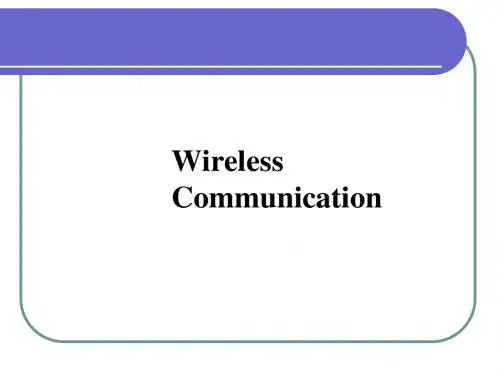
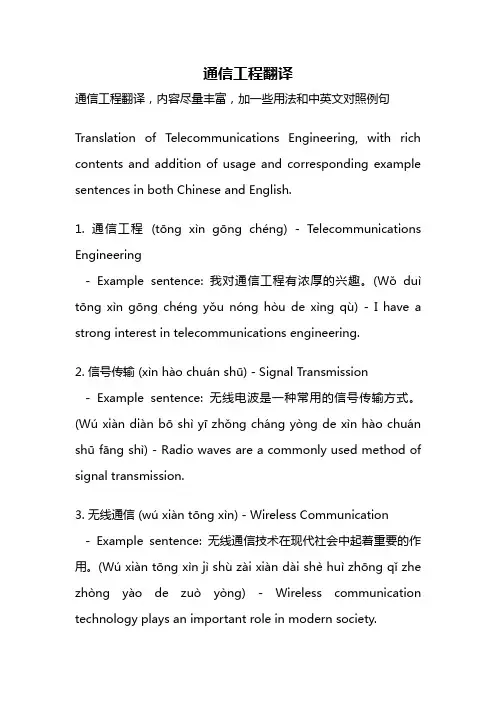
通信工程翻译通信工程翻译,内容尽量丰富,加一些用法和中英文对照例句Translation of Telecommunications Engineering, with rich contents and addition of usage and corresponding example sentences in both Chinese and English.1. 通信工程(tōng xìn gōng chéng) - Telecommunications Engineering- Example sentence: 我对通信工程有浓厚的兴趣。
(Wǒ duì tōng xìn gōng chéng yǒu nóng hòu de xìng qù) - I have a strong interest in telecommunications engineering.2. 信号传输(xìn hào chuán shū) - Signal Transmission- Example sentence: 无线电波是一种常用的信号传输方式。
(Wú xiàn diàn bō shì yī zhǒng cháng yòng de xìn hào chuán shū fāng shì) - Radio waves are a commonly used method of signal transmission.3. 无线通信(wú xiàn tōng xìn) - Wireless Communication- Example sentence: 无线通信技术在现代社会中起着重要的作用。
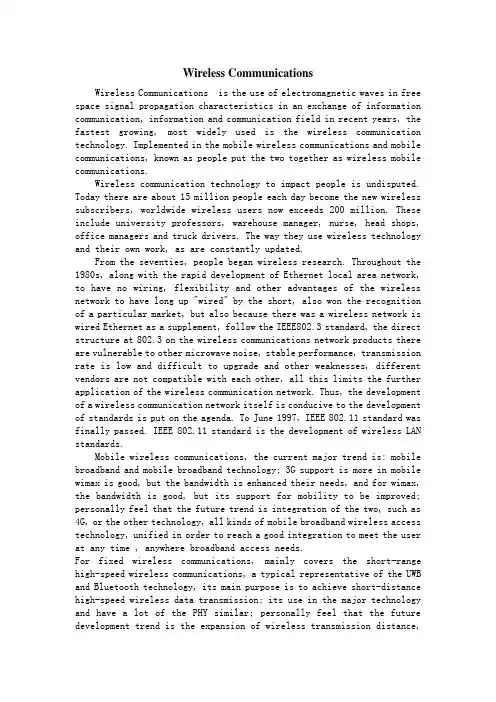
Wireless CommunicationsWireless Communications is the use of electromagnetic waves in free space signal propagation characteristics in an exchange of information communication, information and communication field in recent years, the fastest growing, most widely used is the wireless communication technology. Implemented in the mobile wireless communications and mobile communications, known as people put the two together as wireless mobile communications.Wireless communication technology to impact people is undisputed. Today there are about 15 million people each day become the new wireless subscribers, worldwide wireless users now exceeds 200 million. These include university professors, warehouse manager, nurse, head shops, office managers and truck drivers. The way they use wireless technology and their own work, as are constantly updated.From the seventies, people began wireless research. Throughout the 1980s, along with the rapid development of Ethernet local area network, to have no wiring, flexibility and other advantages of the wireless network to have long up "wired" by the short, also won the recognition of a particular market, but also because there was a wireless network is wired Ethernet as a supplement, follow the IEEE802.3 standard, the direct structure at 802.3 on the wireless communications network products there are vulnerable to other microwave noise, stable performance, transmission rate is low and difficult to upgrade and other weaknesses, different vendors are not compatible with each other, all this limits the further application of the wireless communication network. Thus, the development of a wireless communication network itself is conducive to the development of standards is put on the agenda. To June 1997, IEEE 802.11 standard was finally passed. IEEE 802.11 standard is the development of wireless LAN standards.Mobile wireless communications, the current major trend is: mobile broadband and mobile broadband technology; 3G support is more in mobile wimax is good, but the bandwidth is enhanced their needs, and for wimax, the bandwidth is good, but its support for mobility to be improved; personally feel that the future trend is integration of the two, such as 4G, or the other technology, all kinds of mobile broadband wireless access technology, unified in order to reach a good integration to meet the user at any time , anywhere broadband access needs.For fixed wireless communications, mainly covers the short-range high-speed wireless communications, a typical representative of the UWB and Bluetooth technology, its main purpose is to achieve short-distance high-speed wireless data transmission; its use in the major technology and have a lot of the PHY similar; personally feel that the future development trend is the expansion of wireless transmission distance,taking account of the better integration of various technologies to meet a variety of conditions, conditions of high-speed access needs of users. Future wireless communication networks should be like? Experts believe that the future of wireless communications network is a comprehensive integrated solution. A variety of wireless technologies in the integration of the network to play its role, to find their own world. From the point of view a wide range of public mobile communications, 3G or super-3G technology will be led to the formation of a wide range of seamless global coverage; and WLAN, WiMAX, UWB and other broadband access technologies, will be different because of their technical characteristics, the or application of different coverage areas, and public mobile communication network to form an effective complement.。
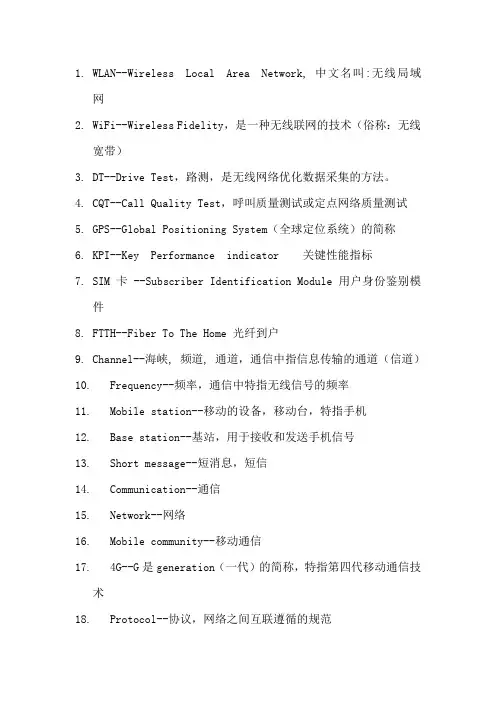
1.WLAN--Wireless Local Area Network, 中文名叫:无线局域网2.WiFi--Wireless Fidelity,是一种无线联网的技术(俗称:无线宽带)3.DT--Drive Test,路测,是无线网络优化数据采集的方法。
4.CQT--Call Quality Test,呼叫质量测试或定点网络质量测试5.GPS--Global Positioning System(全球定位系统)的简称6.KPI--Key Performance indicator 关键性能指标7.SIM卡 --Subscriber Identification Module 用户身份鉴别模件8.FTTH--Fiber To The Home 光纤到户9.Channel--海峡, 频道, 通道,通信中指信息传输的通道(信道)10.Frequency--频率,通信中特指无线信号的频率11.Mobile station--移动的设备,移动台,特指手机12.Base station--基站,用于接收和发送手机信号13.Short message--短消息,短信munication--通信work--网络16.Mobile community--移动通信17.4G--G是generation(一代)的简称,特指第四代移动通信技术18.Protocol--协议,网络之间互联遵循的规范19.Online--在线的,名词可指网游20.Online banking--网上银行21.Wireless--无线,通信领域范畴指的是无线电或无线电波22.Broadcast--广播23.Cell--细胞;电池;蜂房的巢室;单人小室。
移动通信网络中特指小区(基站信号覆盖的范围)24.Satellite Communication-- 卫星通信25.China Mobile--中国移动26.China Telecom--中国电信27.China Unicom--中国联通28.Opted fiber--光纤29.Cable--电缆30.Management--管理31.DC--direct current,直流电32.AC--alternating current,交流电33.DT--Drive Test,无线网络路测34.CQT--Call Quality Test,呼叫质量测试(通信里常称为拨打测试)35.Acceptance of work--工程验收36.Project startup --工程启动37.Preliminary inspection--初验38.Construction quality--工程质量39.Project accounting--项目核算40.Engineering supervision--工程督导41.Project manager--项目经理42.Project engineer--项目工程师43.Project completion--项目竣工44.Unpacking inspection--开箱验货45.Time limit for a project--工期46.抽样量化与编码:sampling,quantizing and coding47.话路:speech channel幅值: amplitude value48.抽样频率: sampling frequency49.抽样速率: sampling rate脉冲流: stream of pulses50.重复率: repetition rate 编码过程: coding process51.模拟信号: analog signal52.传输质量: transmission quality53.数字通信: digital communication54.数字传输: digital transmission55.含噪声的环境: noisy environment56.传输路由: transmission path57信噪比:signal-to-noise ratio58.信号电平:signal levels噪声功率: noise power59地面系统: terrestrial system60.二进制传输: binary transmission61.反向操作: reverse operation62.8-位码序列: 8-digit sequence63.接受端: receiving terminal 帧格式:frame format64.同步字:synchronization word65.串行接口serial interface显示终端CRT terminal发送器与接收器transmitter and receiver数据传输data transmission数据流data stream闲置状态the idle state传号电平mark level空号电位space level起始位start bit停止位stop bitT秒的持续时间duration of T seconds奇偶校检位parity bit错误标志error flag传输错误transmission error下降沿fallinf edge符号间的空格intersymbol space接收机的定时receiver timing本地时钟local clock磁带magnetic tape控制比特control bit逻辑1电平logical 1 level二进制数据binary data通信卫星communication satellite微波设备microwave facilities调制器与解调器modulator and demodulator缓冲器buffer定时信号timing signals同步脉冲synchronization pulses时隙time slot移位寄存器shift register传输媒体transmission medium线形衰弱linear attenuation信息安全information security键盘keyboard数据终端data terminals网络资源:network resource信息服务:information services远程终端:remote terminals互联的系统:interconnected systems命令:command电子邮件:electronic mail主机:host无线信道:wireless channels搜索工具:searching tools用户界面:user interface存取:access文本信息:textual messages协议:protocol超文本协议:hypertext protocol分布在全世界的计算机的巨大网络:gaint network of computers located all over the world主干系统:backbone system全国范围的网络:nationwild network电子会议:electronic conferences实时对话:live conversation最大的信息库the largest repository of the computers on the net网络设备资源:network facilities resources在网上的绝大多数计算机:the vast majority of the computer on the netUNIX操作系统:the UNIX operating system在因特网和你的PC机之间传送数据的方法:a way to move data between the internet and your PC方便的搜索工具:the convenient searching tools联网的超文本协议:the network hypertext protocol光纤通信:optical fiber communications光源:light source波长:wavelength激光器:laser色散:dispersion传输介质:transmission medium多模光纤:multi-mode fiber长途干线:long-houl trunks单模光纤:singer-mode fiber带宽:bandwidth带宽用户:wideband subscriber纤维光学:fiber-optics商用技术:commercial technologe门限电流:threshod current光检测器:photodetector波分复用:wavelength multiplexing纤维光网络:fiber-optic network视频带宽:video bandwidth长途传输:long distance transmission中继距离:repeater spacing已装光纤的总长度:the total length of installed fiber长途通信系统:long-haul telecommunication system低衰减的石英纤维:the low-loss silica fiber波分复用:wavelength multiplexing带宽用户环路系统:widebend subscriber loop system多纤连接器:multifibre connectors设计寿命:projected lifetime光源:light source单模光纤:single-mode fibre分布反馈式激光器:distributed-feedback laser信息容量:information capacity交换体系:switching hierarchy带宽业务:broadband services公用电信网public telecommunication network本地环路local loop交换节点switching node双绞线twisted pair外部呼叫 external call端局end office数字数据系统digital data systems二线连接two wire connection收费中心toll center电路交换网circuit-switching network电话用户telephone subscriber数据流量data traffic链路link中继线 trunk半双工的half-duplex全双工的full-duplex中间交换节点intermediate switching node音频电路voice-frequency circuit汇接交换机tandem switch拓扑topology多媒体multimedia交互环境interactive enviornment视频压缩video compressin高清晰度电视high definition television数字信号处理器digital signal processor点播业务on-demand services视频服务器video servers全球通信global communications灵活性flexibility端到端的数字连接end-to-end digital connectivity开放网络open network语声编码voice encoding综合业务数字网integrated services digital network系统结构infrastructure国际标准化组织International Organization for Standardization 通信载体communication carriers传输媒体transmission medium接口设备interface equipment带宽限制bandwidth limitation交换设备switching equipment语音编码voice encoding脉码调制pulse code modulation基本接入basic accessX.25协议X.25 protocol电视信号television signals宽带业务narrowband services基本接入basic access电信业务teleservice用户电报telex无线电波radio waves地面天线 ground antenna同轴的coaxial直接广播系统direct broadcast system端到端的时延end-to-end delay抖动jitter繁忙小时peak hours芯片技术chip technology高清晰度电视high definition television运行也维护operations and maintenance现有的公用网络the existing public network硬件、软件和应用hardware,software and applications存储storage彩显colour moniter全活动图象full motion picture视频编码器vision encoder字节bytemixture of hardware,software and applications 硬件、软件和应用层interactive environment 交互环境personal desk top computers 个人桌面电脑video compression 视频压缩the vision encoder 视频编码器video-on-demand interactive services 交互式视频点播业务multimedia enviroment 多媒体环境visual images 视频图象hard disk storage 硬盘存储colour monitor 彩显the standards of multimedia 多媒体标准motion pictures 活动图象consumer quality of video and audio 顾客质量的视频和音频broadcast images 广播图象high definition television 高清晰度电视coding algorithms 编码算法digital signals processor 数字信号处理器。
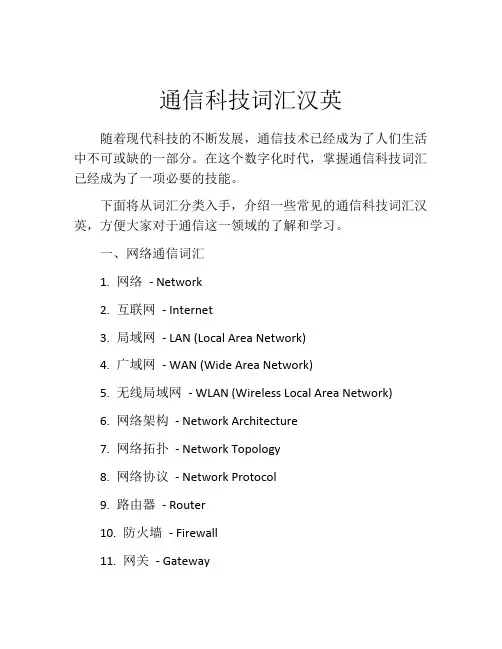
通信科技词汇汉英随着现代科技的不断发展,通信技术已经成为了人们生活中不可或缺的一部分。
在这个数字化时代,掌握通信科技词汇已经成为了一项必要的技能。
下面将从词汇分类入手,介绍一些常见的通信科技词汇汉英,方便大家对于通信这一领域的了解和学习。
一、网络通信词汇1. 网络- Network2. 互联网- Internet3. 局域网- LAN (Local Area Network)4. 广域网- WAN (Wide Area Network)5. 无线局域网- WLAN (Wireless Local Area Network)6. 网络架构- Network Architecture7. 网络拓扑- Network Topology8. 网络协议- Network Protocol9. 路由器- Router10. 防火墙- Firewall11. 网关- Gateway12. 主机- Host13. 客户端- Client14. 服务器- Server15. 网卡- Network Card16. 端口- Port17. 带宽- Bandwidth18. 网络速度- Network Speed19. 网络连接- Network Connection二、移动通信词汇1. 手机- Mobile Phone2. 通话- Call3. 短信- Text Message4. 彩信- MMS (Multimedia Messaging Service)5. 音频通话- Voice Call6. 视频通话- Video Call7. 数据流量- Data Usage8. 网络信号- Network Signal9. 蓝牙- Bluetooth10. Wi-Fi - Wi-Fi11. 移动网络- Mobile Network12. SIM卡- SIM Card13. 手机充电器- Phone Charger14. 手机电池- Phone Battery15. 手机壳- Phone Case三、计算机通信词汇1. 计算机- Computer2. 操作系统- Operating System3. 软件- Software4. 硬件- Hardware5. 数据- Data6. 数据库- Database7. 文件- File8. 程序- Program9. 界面- Interface10. 键盘- Keyboard11. 鼠标- Mouse12. 监视器- Monitor13. 打印机- Printer14. 外存储器- External Storage15. 内存- Memory16. 中央处理器- CPU (Central Processing Unit)17. 图形处理器- GPU (Graphics Processing Unit)18. 网络存储- Network Storage19. 云计算- Cloud Computing四、安全通信词汇1. 加密- Encryption2. 解密- Decryption3. 数字签名- Digital Signature4. 鉴别- Authentication5. 授权- Authorization6. 防抄袭- Anti-Counterfeiting7. 防窃听- Anti-Eavesdropping8. 防病毒- Anti-Virus9. 防钓鱼- Anti-Phishing10. 防火墙- Firewall11. 安全协议- Security Protocol12. 恢复- Recovery13. 备份- Backup14. 安全漏洞- Security Vulnerability15. 安全策略- Security Strategy以上介绍了一些常见的通信科技词汇汉英。
WLAN--Wireless Local Area Network,中文名叫:无线局域网WiFi--Wireless Fidelity,是一种无线联网的技术(俗称:无线宽带)DT--Drive Test,路测,是无线网络优化数据采集的方法。
CQT--Call Quality Test,呼叫质量测试或定点网络质量测试GPS--Global Positioning System(全球定位系统)的简称KPI--Key Performance indicator 关键性能指标SIM卡--Subscriber Identification Module 用户身份鉴别模件FTTH--Fiber To The Home 光纤到户Channel--海峡, 频道, 通道,通信中指信息传输的通道(信道)Frequency--频率,通信中特指无线信号的频率Mobile station--移动的设备,移动台,特指手机Base station--基站,用于接收和发送手机信号Short message--短消息,短信Communication--通信Network--网络Mobile community--移动通信4G--G是generation(一代)的简称,特指第四代移动通信技术Protocol--协议,网络之间互联遵循的规范Online--在线的,名词可指网游Online banking--网上银行Wireless--无线,通信领域范畴指的是无线电或无线电波Broadcast--广播Cell--细胞;电池;蜂房的巢室;单人小室。
移动通信网络中特指小区(基站信号覆盖的范围)Satellite Communication--卫星通信China Mobile--中国移动China Telecom--中国电信China Unicom--中国联通Opted fiber--光纤Cable--电缆Management--管理DC--direct current,直流电AC--alternating current,交流电DT--Drive Test,无线网络路测CQT--Call Quality Test,呼叫质量测试(通信里常称为拨打测试)Acceptance of work--工程验收Project startup --工程启动Preliminary inspection--初验Construction quality--工程质量Project accounting--项目核算Engineering supervision--工程督导Project manager--项目经理Project engineer--项目工程师Project completion--项目竣工Unpacking inspection--开箱验货Time limit for a project--工期抽样量化与编码:sampling,quantizing and coding 话路:speech channel幅值: amplitude value抽样频率: sampling frequency抽样速率: sampling rate脉冲流: stream of pulses 重复率: repetition rate 编码过程: coding process 模拟信号: analog signal传输质量: transmission quality数字通信: digital communication数字传输: digital transmission含噪声的环境: noisy environment传输路由: transmission path信噪比:signal-to-noise ratio信号电平:signal levels噪声功率: noise power地面系统: terrestrial system二进制传输: binary transmission反向操作: reverse operation8-位码序列: 8-digit sequence接受端: receiving terminal 帧格式:frame format 同步字:synchronization word串行接口serial interface显示终端CRT terminal发送器与接收器transmitter and receiver 数据传输data transmission数据流data stream闲置状态the idle state传号电平mark level空号电位space level起始位start bit停止位stop bitT秒的持续时间duration of T seconds 奇偶校检位parity bit错误标志error flag传输错误transmission error下降沿fallinf edge符号间的空格intersymbol space接收机的定时receiver timing本地时钟local clock磁带magnetic tape控制比特control bit逻辑1电平logical 1 level二进制数据binary data通信卫星communication satellite微波设备microwave facilities调制器与解调器modulator and demodulator 缓冲器buffer定时信号timing signals同步脉冲synchronization pulses时隙time slot移位寄存器shift register传输媒体transmission medium线形衰弱linear attenuation信息安全information security键盘keyboard数据终端data terminals网络资源:network resource信息服务:information services远程终端:remote terminals互联的系统:interconnected systems命令:command电子邮件:electronic mail主机:host无线信道:wireless channels搜索工具:searching tools用户界面:user interface存取:access文本信息:textual messages协议:protocol超文本协议:hypertext protocol分布在全世界的计算机的巨大网络:gaint network of computers located all over the world 主干系统:backbone system全国范围的网络:nationwild network电子会议:electronic conferences实时对话:live conversation最大的信息库the largest repository of the computers on the net网络设备资源:network facilities resources在网上的绝大多数计算机:the vast majority of the computer on the netUNIX操作系统:the UNIX operating system在因特网和你的PC机之间传送数据的方法:a way to move data between the internet and your PC方便的搜索工具:the convenient searching tools联网的超文本协议:the network hypertext protocol光纤通信:optical fiber communications光源:light source波长:wavelength激光器:laser色散:dispersion传输介质:transmission medium长途干线:long-houl trunks单模光纤:singer-mode fiber带宽:bandwidth带宽用户:wideband subscriber纤维光学:fiber-optics商用技术:commercial technologe门限电流:threshod current光检测器:photodetector波分复用:wavelength multiplexing纤维光网络:fiber-optic network视频带宽:video bandwidth长途传输:long distance transmission中继距离:repeater spacing已装光纤的总长度:the total length of installed fiber 长途通信系统:long-haul telecommunication system 低衰减的石英纤维:the low-loss silica fiber波分复用:wavelength multiplexing带宽用户环路系统:widebend subscriber loop system 多纤连接器:multifibre connectors设计寿命:projected lifetime光源:light source分布反馈式激光器:distributed-feedback laser信息容量:information capacity交换体系:switching hierarchy带宽业务:broadband services公用电信网public telecommunication network 本地环路local loop交换节点switching node双绞线twisted pair外部呼叫external call端局end office数字数据系统digital data systems二线连接two wire connection收费中心toll center电路交换网circuit-switching network电话用户telephone subscriber数据流量data traffic链路link中继线trunk半双工的half-duplex全双工的full-duplex中间交换节点intermediate switching node音频电路voice-frequency circuit汇接交换机tandem switch拓扑topology多媒体multimedia交互环境interactive enviornment视频压缩video compressin高清晰度电视high definition television数字信号处理器digital signal processor点播业务on-demand services视频服务器video servers全球通信global communications灵活性flexibility端到端的数字连接end-to-end digital connectivity开放网络open network语声编码voice encoding综合业务数字网integrated services digital network系统结构infrastructure国际标准化组织International Organization for Standardization 通信载体communication carriers传输媒体transmission medium接口设备interface equipment带宽限制bandwidth limitation交换设备switching equipment语音编码voice encoding脉码调制pulse code modulation基本接入basic accessX.25协议X.25 protocol电视信号television signals宽带业务narrowband services基本接入basic access电信业务teleservice用户电报telex无线电波radio waves地面天线ground antenna同轴的coaxial直接广播系统direct broadcast system端到端的时延end-to-end delay抖动jitter繁忙小时peak hours芯片技术chip technology高清晰度电视high definition television运行也维护operations and maintenance现有的公用网络the existing public network硬件、软件和应用hardware,software and applications存储storage彩显colour moniter全活动图象full motion picture视频编码器vision encoder字节bytemixture of hardware,software and applications 硬件、软件和应用层interactive environment 交互环境personal desk top computers 个人桌面电脑video compression 视频压缩the vision encoder 视频编码器video-on-demand interactive services 交互式视频点播业务multimedia enviroment 多媒体环境visual images 视频图象hard disk storage 硬盘存储colour monitor 彩显the standards of multimedia 多媒体标准motion pictures 活动图象consumer quality of video and audio 顾客质量的视频和音频broadcast images 广播图象high definition television 高清晰度电视coding algorithms 编码算法digital signals processor 数字信号处理器谢谢观看! 欢迎您的下载,资料仅供参考,如有雷同纯属意外。
1.3 Technical IssuesMany technical challenges must be addressed to enable the wireless applications of the future. These challenges extend across all aspects of the system design. As wireless terminals add more features, these small devices must incorporate multiple modes of operation to support the different applications and media. Computers process voice, image, text, and video data, but breakthroughs in circuit design are required to implement the same multimode operation in a cheap, lightweight, handhe ld device. Since consumers don’t want large batteries that frequently need recharging, transmission and signal processing in the portable terminal must consume minimal power. The signal processing required to support multimedia applications and networking functions can be power-intensive. Thus, wireless infrastructure-based networks, such as wireless LANs and cellular systems, place as much of the processing burden as possible on fixed sites with large power resources. The associated bottlenecks and single points-of-failure are clearly undesirable for the overall system. Ad hoc wireless networks without infrastructure are highly appealing for many ap plications due to their flexibility and robustness. For these networks all processing and control must be performed by the network nodes in a distributed fashion, making energy-efficiency challenging to achieve. Energy is a particularly critical resource in networks where nodes cannot recharge their batteries, for example in sensing applications. Network design to meet the application requirements under such hard energy constraints remains a big technological hurdle. The finite bandwidth and random variations of wireless channels also requires robust applications that degrade gracefully as network performance degrades.Design of wireless networks differs fundamentally from wired network design due to the nature of the wireless channel. This channel is an unpred ictable and difficult communications medium. First of all, the radio spectrum is a scarce resource that must be allocated to many different applications and systems. For this reason spectrum is controlled by regulatory bodies both regionally and globally. A regional or global system operating in a given frequency band must obey the restrictions for that band set forth by the corresponding regulatory body. Spectrum can also be very expensive since in many countries spectral licenses are often auctioned to the highest bidder. In the U.S. companies spent over nine billion dollars for second generation cellular licenses, and the auctions in Europe for third generation cellular spectrum garnered around 100 billion dollars. The spectrum obtained through these aucti ons must be used extremely efficiently to get a reasonable return on its investment, and it must also be reused over and over in the same geographical area, thus requiring cellular system designs with high capacity and good performance. At frequencies around several Gigahertz wireless radio components with reasonable size, power consumption, and cost are available. However, the spectrum in this frequency range is extremely crowded. Thus, technological breakthroughs to enable higher frequency systems with the same cost and performance would greatly reduce the spectrum shortage. However, path loss at these higher frequencies is larger, thereby limiting range, unless directional antennas are used.As a signal propagates through a wireless channel, it experiences randomfluctuations in time if the transmitter, receiver, or surrounding objects are moving, due to changing reflections and attenuation. Thus, the characteristics of the channel appear to change randomly with time, which makes it difficult to design reliable systems with guaranteed performance. Security is also more difficult to implement in wireless systems, since the airwaves are susceptible to snooping from anyone with an RF antenna. The analog cellular systems have no security, and one can easily listen in on conversations by scanning the analog cellular frequency band. All digital cellularsystems implement some level of encryption. However, with enough knowledge, time and determination most of these encryption methods can be cracked and, indeed, several have been compromised. To support applications like electronic commerce and credit card transactions, the wireless network must be secure against such listeners.W ireless networking is also a significant challenge. The network must be able to locate a given user wherever it is among billions of globally-distributed mobile terminals. It must then route a call to that user as it moves at speeds of up to 100 Km/hr. The finite resources of the network must be allocated in a fair and efficient manner relative to changing user demands and locations. Moreover, there currently exists a tremendous infrastructure of wired networks: the telephone system, the Internet, and fiber opt ic cable, which should be used to connect wireless systems together into a global network. However, wireless systems with mobile users will never be able to compete with wired systems in terms of data rates and reliability. Interfacing between wireless and wired networks with vastly different performance capabilities is a difficult problem.Perhaps the most significant technical challenge in wireless network design is an overhaul of the design process itself. Wired networks are mostly designed according to a layered approach, whereby protocols associated with different layers of the system operation are designed in isolation, with baseline mechanisms to interface between layers. The layers in a wireless systems include the link or physical layer, which handles bit transmissions over the communications medium, the access layer, which handles shared access to the communications medium,the network and transport layers, which routes data across the network and insure end-to-end connectivity and data delivery, and the application layer, which dictates the end-to-end data rates and delay constraints associated with the application. While a layering methodology reduces complexity and facilitates modularity and standardization, it also leads to inefficiency and performance loss due to the lack of a global design optimization. The large capacity and good reliability of wired networks make these inefficiencies relatively benign for many wired network applications, although it does preclude good performance of delay-constrained applications such as voice and video. The situation is very different in a wireless network. Wireless links can exhibit very poor performance, and this performance along with user connectivity and network topology changes over time. In fact, the very notion of a wireless link is somewhat fuzzy due to the nature of radio propagation and broadcasting. The dynamic nature and poor performance of the underlying wireless communication channel indicates that high-performance networks must be optimized for this channel and must be robust and adaptive to its variations, as well as to network dynamics. Thus, these networks require integrated and adaptive protocols at all layers, from the link layer to the application layer. This cross-layer protocol design requires interdiciplinary expertise in communications, signal processing, and network theory and design.In the next section we give an overview of the wireless systems in operation today. It will be clear from this overview that the wireless vision remains a distant goal, with many technical challenges to overcome. These challenges will be examined in detail throughout the book.1.4 CurrentWireless SystemsThis section provides a brief overview of current wireless systems in operation today. The design details of these system are constantly evolving, with new systems emerging and old ones going by the wayside. Thus, we will focus mainly on the high-level design aspects of the most common systems. More details on wireless system standards can be found in [1, 2, 3] A summary of the main wireless system standards is given in Appendix D.1.4.1 Cellular Telephone SystemsCellular telephone systems are extremely popular and lucrative worldwide: these are the systems that ignited the wireless revolution. Cellular systems provide two-way voice and data communication with regional, national, or international coverage. Cellular systems were initially designed for mobile terminals inside vehicles with antennas mounted on the vehicle roof. Today these systems have evolved to support lightweight handheld mobile terminals operating inside and outside buildings at both pedestrian and vehicle speeds.The basic premise behind cellular system design is frequency reuse, which exploits the fact that signal power falls off with distance to reuse the same frequency spectrum at spatially-separated locations. Specifically, the coverage area of a cellular system is divided into nonoverlapping cells where some set of channels is assigned to each cell. This same channel set is used in another cell some distance away, as shown in Figure 1.1, where Ci denotes the channel set used in a particular cell. Operation within a cell is controlled by a centralized base station, as described in more detail below. The interference caused by users in different cells operating on the same channel set is called intercell interference. The spatial separation of cells that reuse the same channel set, the reuse distance, should be as small as possible so that frequencies are reused as often as possible, thereby maximizing spectral efficiency. However, as the reuse distance decreases, intercell interference increases, due to the smaller propagation distance between interfering cells. Since intercell interference must remain below a given threshold for acceptable system performance, reuse distance cannot be reduced below some minimum value. In practice it is quite difficult to determine this minimum value since both the transmitting and interfering signals experience random power variations due to the characteristics of wireless signal propagation. In order to determine the best reuse distance and base station placement, an accurate characterization of signal propagation within the cells is needed.Initial cellular system designs were mainly driven by the high cost of base stations, approximately one million dollars apiece. For this reason early cellular systems used a relatively small number of cells to cover an entire city or region. The cell base stations were placed on tall buildings or mountains and transmitted at very high power with cell coverage areas of several square miles. These large cells are called macrocells. Signal power was radiated uniformly in all directions, so a mobile moving in a circle around the base station would have approximately constant received power if the signal was not blocked by an attenuating object. This circular contour of constant power yields a hexagonal cell shape for the system, since a hexagon is the closest shape to a circle that can cover a given area with multiple nonoverlapping cells.Cellular systems in urban areas now mostly use smaller cells with base stations close to street level transmitting at much lower power. These smaller cells are called microcells or picocells, depending on their size. This evolution to smaller cells occured for two reasons: the need for higher capacity in areas with high user density and the reduced size and cost of base station electronics. A cell of any size can support roughly the same number of users if the system is scaled accordingly. Thus, for a given coverage area a system with many microcells has a higher number of users per unit area than a system with just a few macrocells. In addition, less power is required at the mobile terminals in microcellular systems, since the terminals are closer to the base stations. However, the evolution to smaller cells has complicated network design. Mobiles traverse a small cell more quickly than a large cell, and therefore handoffs must be processed more quickly. In addition, location management becomes more complicated, since there are more cells within agiven area where a mobile may be located. It is also harder to develop general propagation models for small cells, since signal propagation in these cells is highly dependent on base station placement and the geometry of the surrounding reflectors. In particular, a hexagonal cell shape is generally not a good approximation to signal propagation in microcells. Microcellular systems are often designed using square or triangular cell shapes, but these shapes have a large margin of error in their approximation to microcell signal propagation [9].All base stations in a given geographical area are connected via a high-speed communications link to a mobile telephone switching office (MTSO), as shown in Figure 1.2. TheMTSO acts as a central controller for the network, allocating channels within each cell, coordinating handoffs between cells when a mobile traverses a cell boundary, and routing calls to and from mobile users. The MTSO can route voice calls through the public switched telephone network (PSTN) or provide Internet access. A new user located in a given cell requests a channel by sending a call request to the cell’s base station over a separate control channel. The request is relayed to theMTSO, which accepts the call request if a channel is available in that cell. If no channels are available then the call request is rejected. A call handoff is initiated when the base station or the mobile in a given cell detects that the received signal power for that call is approaching a given minimum threshold. In this case the base station informs theMTSO that the mobile requires a handoff, and the MTSO then queries surrounding base stations to determine if one of these stations can detect that mobile’s signal. If so then the MTSO co ordinates a handoff between the original base station and the new base station. If no channels are available in the cell with the new base station then the handoff fails and the call is terminated. A call will also be dropped if the signal strength between a mobile and its base station drops below the minimum threshold needed for communication due to random signal variations.The first generation of cellular systems used analog communications, since they were primarily designed in the 1960’s, before digital communications became prevalent. Second generation systems moved from analog to digital due to its many advantages. The components are cheaper, faster, smaller, and require less power. V oice quality is improved due to error correction coding. Digital systems also have higher capacity than analog systems since they can use more spectrally-efficient digital modulation and more efficient techniques to share the cellular spectrum. They can also take advantage of advanced compression techniques and voice activity factors. In addition, encryption techniques can be used to secure digital signals against eavesdropping. Digital systems can also offer data services in addition to voice, including short messaging, email, Internet access, and imaging capabilities (camera phones). Due to their lower cost and higher efficiency, service providers used aggressive pricing tactics to encourage user migration from analog to digital systems, and today analog systems are primarily used in areas with no digital service. However, digital systems do not always work as well as the analog ones. Users can experience poor voice quality, frequent call dropping, and spotty coverage in certain areas. System performance has certainly improved as the technology and networks mature. In some areas cellular phones provide almost the same quality as landline service. Indeed, some people have replaced their wireline telephone service inside the home with cellular service.Spectral sharing in communication systems, also called multiple access, is done by dividing the signaling dimensions along the time, frequency, and/or code space axes. In frequency-division multiple access (FDMA) the total system bandwidth is divided into orthogonal frequency channels. In time-division multiple access (TDMA) time is divided orthogonally and each channel occupiesthe entire frequency band over its assigned timeslot. TDMA is more difficult to implement than FDMA since the users must be time-synchronized. However, it is easier to accommodate multiple data rates with TDMA since multiple timeslots can be assigned to a given user. Code-division multiple access (CDMA) is typically implemented using direct-sequence or frequency-hopping spread spectrum with either orthogonal or non-orthogonal codes. In direct-sequence each user modulates its data sequence by a different chip sequence which is much faster than the data sequence. In the frequency domain, the narrowband data signal is convolved with the wideband chip signal, resulting in a signal with a much wider bandwidth than the original data signal. In frequency-hopping the carrier frequency used to modulate the narrowband data signal is varied by a chip sequence which may be faster or slower than the data sequence. This results in a modulated signal that hops over different carrier frequencies. Typically spread spectrum signals are superimposed onto each other within the same signal bandwidth. A spread spectrum receiver separates out each of the distinct signals by separately decoding each spreading sequence. However, for non-orthogonal codes users within a cell interfere with each other (intracell interference) and codes that are reused in other cells cause intercell interference. Both the intracell and intercell interference power is reduced by the spreading gain of the code. Moreover, interference in spread spectrum systems can be further reduced through multiuser detection and interference cancellation. More details on these different techniques for spectrum sharing and their performance analysis will be given in Chapters 13-14. The design tradeoffs associated with spectrum sharing are very complex, and the decision of which technique is best for a given system and operating environment is never straightforward.Efficient cellular system designs are interference-limited, i.e. the interference dominates the noise floor since otherwise more users could be added to the system. As a result, any technique to reduce interference in cellular systems leads directly to an increase in system capacity and performance. Some methods for interference reduction in use today or proposed for future systems include cell sectorization, directional and smart antennas, multiuser detection, and dynamic resource allocation. Details of these techniques will be given in Chapter 15.The first generation (1G) cellular systems in the U.S., called the Advance Mobile Phone Service (AMPS), used FDMA with 30 KHz FM-modulated voice channels. The FCC initially allocated 40 MHz of spectrum to this system, which was increased to 50 MHz shortly after service introduction to support more users. This total bandwidth was divided into two 25 MHz bands, one for mobile-to-base station channels and the other for base station-to-mobile channels. The FCC divided these channels into two sets that were assigned to two different service providers in each city to encourage competition. A similar system, the European Total Access Communication System (ETACS), emerged in Europe. AMPS was deployed worldwide in the 1980’s and remains the only cellular service in some of these areas, including some rural parts of the U.S.Many of the first generation cellular systems in Europe were incompatible, and the Europeans quickly converged on a uniform standard for second generation (2G) digital systems called GSM 1. The GSM standard uses a combination of TDMA and slow frequency hopping with frequency-shift keying for the voice modulation. In contrast, the standards activities in the U.S. surrounding the second generation of digital cellular provoked a raging debate on spectrum sharing techniques, resulting in several incompatible standards [10, 11, 12]. In particular, there are two standards in the 900 MHz cellular frequency band: IS-54, which uses a combination of TDMA and FDMA and phase-shift keyed modulation, and IS-95, which uses direct-sequenceCDMA with binary modulation and coding [13, 14]. The spectrum for digital cellular in the 2 GHz PCS frequency band was auctioned off, so service providers could use an existing standard or develop proprietary systems for their purchased spectrum. The end result has been three different digital cellular standards for this frequency band: IS-136 (which is basically the same as IS-54 at a higher frequency), IS-95, and the European GSM standard. The digital cellular standard in Japan is similar to IS-54 and IS-136 but in a different frequency band, and the GSM system in Europe is at a different frequency than the GSM systems in the U.S. This proliferation of incompatible standards in the U.S. and internationally makes it impossible to roam between systems nationwide or globally without a multi-mode phone and/or multiple phones (and phone numbers).All of the second generation digital cellular standards have been enhanced to support high rate packet data services [15]. GSM systems provide data rates of up to 100 Kbps by aggregating all timeslots together for a single user. This enhancement is called GPRS. A more fundamental enhancement, Enhanced Data Services for GSM Evolution (EDGE), further increases data rates using a high-level modulation format combined with FEC coding. This modulation is more sensitive to fading effects, and EDGE uses adaptive techniques to mitigate this problem.Specifically, EDGE defines six different modulation and coding combinations, each optimized to a different value of received SNR. The received SNR is measured at the receiver and fed back to the transmitter, and the best modulation and coding combination for this SNR value is used. The IS-54 and IS-136 systems currently provide data rates of 40-60 Kbps by aggregating time slots and using high-level modulation. This evolution of the IS-136 standard is called IS-136HS (high-speed). The IS-95 systems support higher data using a time-division technique called high data rate (HDR)[16].The third generation (3G) cellular systems are based on a wideband CDMA standard developed within the auspices of the International Telecommunications Union (ITU) [15]. The standard, initially called International Mobile Telecommunications 2000 (IMT-2000), provides different data rates depending on mobility and location, from 384 Kbps for pedestrian use to 144 Kbps for vehicular use to 2 Mbps for indoor office use. The 3G standard is incompatible with 2G systems, so service providers must invest in a new infrastructure before they can provide 3G service. The first 3G systems were deployed in Japan. One reason that 3G services came out first in Japan is the process of 3G spectrum allocation, which in Japan was awarded without much up-front cost. The 3G spectrum in both Europe and the U.S. is allocated based on auctioning, thereby requiring a huge initial investment for any company wishing to provide 3G service. European companies collectively paid over 100 billion dollars in their 3G spectrum auctions. There has been much controversy over the 3G auction process in Europe, with companies charging that the nature of the auctions caused enormous overbidding and that it will be very difficult if not impossible to reap a profit on this spectrum. A few of the companies have already decided to write off their investment in 3G spectrum and not pursue system buildout. In fact 3G systems have not grown as anticipated in Europe, and it appears that data enhancements to 2G systems may suffice to satisfy user demands. However,the 2G spectrum in Europe is severely overcrowded, so users will either eventually migrate to 3G or regulations will change so that 3G bandwidth can be used for 2G services (which is not currently allowed in Europe). 3G development in the U.S. has lagged far behind that of Europe. The available 3G spectrum in the U.S. is only about half that available in Europe. Due to wrangling about which parts of the spectrum will be used, the 3G spectral auctions in the U.S. have not yet taken place. However, theU.S. does allow the 1G and 2G spectrum to be used for 3G, and this flexibility may allow a more gradual rollout and investment than the more restrictive 3G requirements in Europe. It appears that delaying 3G in the U.S. will allow U.S. service providers to learn from the mistakes andsuccesses in Europe and Japan.。
中文名称:无线通信英文名称:wireless communication定义:仅利用电磁波而不通过线缆进行的通信方式。
与有线通信相对。
应用学科:通信科技(一级学科);通信原理与基本技术(二级学科)无线通信主要包括微波通信和卫星通信。
微波是一种无线电波,它传送的距离一般只有几十千米。
但微波的频带很宽,通信容量很大。
微波通信每隔几十千米要建一个微波中继站。
卫星通信是利用通信卫星作为中继站在地面上两个或多个地球站之间或移动体之间建立微波通信联系。
定义无线通信(Wireless Communication)是利用电磁波信号可以在自由空间中传播的特性进行信息交换的一种通信方式,近些年信息通信领域中,发展最快、应用最广的就是无线通信技术。
在移动中实现的无线通信又通称为移动通信,人们把二者合称为无线移动通信。
从最初的电报开始经过150多年的现代电信的发展是来自各界的成千上万科学家、工程师和研究人员的辛勤劳动的结果。
他们当中只有少数独立负责发明的人成了名,而大多数达到顶点的发明是许多个人的成果。
这里汇集了部分对于无线电通信发展中起到重要作用的历史人物。
1859年3月16日生于乌克兰。
1906年1月13日在圣彼得堡去世。
波波夫是圣彼得堡附近的Kronstadt的诺罗斯皇家海军学校的物理讲师。
在赫兹演示他的电磁波的存在之后,波波夫进行了利用接收机监测电磁波存在的实验。
在1895年5月7日向诺罗斯物理和化学学会演示了他的实验,几天后,在喀琅施塔德斯基提出报告。
该报告的结论是试验的目的,“是为了显示在一定距离不用导线传送信号在理论上是可行的,换句话说,发送无线电报,必须借助电磁发射”。
斯戳格(Strowger):1838年生于Rochester附近。
1902年去世。
在1889年他发明了自动电话交换机,他觉察到由于设计或差错,本地电话操作者将其业务电话接到他的竞争对手的电话局。
因此,他有了自动电话交换机的设想,根据这个思想终于在美国的La Port( Indiana)安装了世界第一个商用自动交换机。
1.WLAN--Wireless Local Area Network, 中文名叫:无线局域网2.WiFi--Wireless Fidelity,是一种无线联网的技术(俗称:无线宽带)3.DT--Drive Test,路测,是无线网络优化数据采集的方法。
4.CQT--Call Quality Test,呼叫质量测试或定点网络质量测试5.GPS--Global Positioning System(全球定位系统)的简称6.KPI--Key Performance indicator 关键性能指标7.SIM卡 --Subscriber Identification Module 用户身份鉴别模件8.FTTH--Fiber To The Home 光纤到户9.Channel--海峡, 频道, 通道,通信中指信息传输的通道(信道)10.Frequency--频率,通信中特指无线信号的频率11.Mobile station--移动的设备,移动台,特指手机12.Base station--基站,用于接收和发送手机信号13.Short message--短消息,短信munication--通信work--网络16.Mobile community--移动通信17.4G--G是generation(一代)的简称,特指第四代移动通信技术18.Protocol--协议,网络之间互联遵循的规范19.Online--在线的,名词可指网游20.Online banking--网上银行21.Wireless--无线,通信领域范畴指的是无线电或无线电波22.Broadcast--广播23.Cell--细胞;电池;蜂房的巢室;单人小室。
移动通信网络中特指小区(基站信号覆盖的范围)24.Satellite Communication-- 卫星通信25.China Mobile--中国移动26.China Telecom--中国电信27.China Unicom--中国联通28.Opted fiber--光纤29.Cable--电缆30.Management--管理31.DC--direct current,直流电32.AC--alternating current,交流电33.DT--Drive Test,无线网络路测34.CQT--Call Quality Test,呼叫质量测试(通信里常称为拨打测试)35.Acceptance of work--工程验收36.Project startup --工程启动37.Preliminary inspection--初验38.Construction quality--工程质量39.Project accounting--项目核算40.Engineering supervision--工程督导41.Project manager--项目经理42.Project engineer--项目工程师43.Project completion--项目竣工44.Unpacking inspection--开箱验货45.Time limit for a project--工期46.抽样量化与编码:sampling,quantizing and coding47.话路:speech channel幅值: amplitude value48.抽样频率: sampling frequency49.抽样速率: sampling rate脉冲流: stream of pulses50.重复率: repetition rate 编码过程: coding process51.模拟信号: analog signal52.传输质量: transmission quality53.数字通信: digital communication54.数字传输: digital transmission55.含噪声的环境: noisy environment56.传输路由: transmission path57信噪比:signal-to-noise ratio58.信号电平:signal levels噪声功率: noise power59地面系统: terrestrial system60.二进制传输: binary transmission61.反向操作: reverse operation62.8-位码序列: 8-digit sequence63.接受端: receiving terminal 帧格式:frame format64.同步字:synchronization word65.串行接口serial interface显示终端CRT terminal发送器与接收器transmitter and receiver数据传输data transmission数据流data stream闲置状态the idle state传号电平mark level空号电位space level起始位start bit停止位stop bitT秒的持续时间duration of T seconds奇偶校检位parity bit错误标志error flag传输错误transmission error下降沿fallinf edge符号间的空格intersymbol space接收机的定时receiver timing本地时钟local clock磁带magnetic tape控制比特control bit逻辑1电平logical 1 level二进制数据binary data通信卫星communication satellite微波设备microwave facilities调制器与解调器modulator and demodulator缓冲器buffer定时信号timing signals同步脉冲synchronization pulses时隙time slot移位寄存器shift register传输媒体transmission medium线形衰弱linear attenuation信息安全information security键盘keyboard数据终端data terminals网络资源:network resource信息服务:information services远程终端:remote terminals互联的系统:interconnected systems命令:command电子邮件:electronic mail主机:host无线信道:wireless channels搜索工具:searching tools用户界面:user interface存取:access文本信息:textual messages协议:protocol超文本协议:hypertext protocol分布在全世界的计算机的巨大网络:gaint network of computers located all over the world主干系统:backbone system全国范围的网络:nationwild network电子会议:electronic conferences实时对话:live conversation最大的信息库the largest repository of the computers on the net网络设备资源:network facilities resources在网上的绝大多数计算机:the vast majority of the computer on the netUNIX操作系统:the UNIX operating system在因特网和你的PC机之间传送数据的方法:a way to move data between the interne t and your PC方便的搜索工具:the convenient searching tools联网的超文本协议:the network hypertext protocol光纤通信:optical fiber communications光源:light source波长:wavelength激光器:laser色散:dispersion传输介质:transmission medium多模光纤:multi-mode fiber长途干线:long-houl trunks单模光纤:singer-mode fiber带宽:bandwidth带宽用户:wideband subscriber纤维光学:fiber-optics商用技术:commercial technologe门限电流:threshod current光检测器:photodetector波分复用:wavelength multiplexing纤维光网络:fiber-optic network视频带宽:video bandwidth长途传输:long distance transmission中继距离:repeater spacing已装光纤的总长度:the total length of installed fiber长途通信系统:long-haul telecommunication system低衰减的石英纤维:the low-loss silica fiber波分复用:wavelength multiplexing带宽用户环路系统:widebend subscriber loop system多纤连接器:multifibre connectors设计寿命:projected lifetime光源:light source单模光纤:single-mode fibre分布反馈式激光器:distributed-feedback laser信息容量:information capacity交换体系:switching hierarchy带宽业务:broadband services公用电信网public telecommunication network本地环路local loop交换节点switching node双绞线twisted pair外部呼叫 external call端局end office数字数据系统digital data systems二线连接two wire connection收费中心toll center电路交换网circuit-switching network电话用户telephone subscriber数据流量data traffic链路link中继线 trunk半双工的half-duplex全双工的full-duplex中间交换节点intermediate switching node音频电路voice-frequency circuit汇接交换机tandem switch拓扑topology多媒体multimedia交互环境interactive enviornment视频压缩video compressin高清晰度电视high definition television数字信号处理器digital signal processor点播业务on-demand services视频服务器video servers全球通信global communications灵活性flexibility端到端的数字连接end-to-end digital connectivity开放网络open network语声编码voice encoding综合业务数字网integrated services digital network系统结构infrastructure国际标准化组织International Organization for Standardization 通信载体communication carriers传输媒体transmission medium接口设备interface equipment带宽限制bandwidth limitation交换设备switching equipment语音编码voice encoding脉码调制pulse code modulation基本接入basic accessX.25协议X.25 protocol电视信号television signals宽带业务narrowband services基本接入basic access电信业务teleservice用户电报telex无线电波radio waves地面天线 ground antenna同轴的coaxial直接广播系统direct broadcast system端到端的时延end-to-end delay抖动jitter繁忙小时peak hours芯片技术chip technology高清晰度电视high definition television运行也维护operations and maintenance现有的公用网络the existing public network硬件、软件和应用hardware,software and applications存储storage彩显colour moniter全活动图象full motion picture视频编码器vision encoder字节bytemixture of hardware,software and applications 硬件、软件和应用层interactive environment 交互环境personal desk top computers 个人桌面电脑video compression 视频压缩the vision encoder 视频编码器video-on-demand interactive services 交互式视频点播业务multimedia enviroment 多媒体环境visual images 视频图象hard disk storage 硬盘存储colour monitor 彩显the standards of multimedia 多媒体标准motion pictures 活动图象consumer quality of video and audio 顾客质量的视频和音频broadcast images 广播图象high definition television 高清晰度电视coding algorithms 编码算法digital signals processor 数字信号处理器。
无线通信的英语作文Wireless Communication。
In today's world, wireless communication plays acrucial role in connecting people and devices seamlessly. From smartphones to IoT devices, wireless technologies enable us to communicate and access information without the constraints of wires. This essay explores the evolution, benefits, and challenges of wireless communication.Wireless communication began with the invention of the radio by Guglielmo Marconi in the late 19th century. Since then, it has evolved significantly, leading to the development of technologies like Wi-Fi, Bluetooth, and cellular networks. These technologies have revolutionized the way we live, work, and communicate.One of the key benefits of wireless communication isits convenience. With wireless technologies, we can communicate from virtually anywhere, as long as there isnetwork coverage. This has greatly improved productivity and efficiency, allowing people to work remotely and stay connected while on the go.Wireless communication has also transformed the way we access information. With the advent of smartphones and mobile internet, we can now access a wealth of information with just a few taps on a screen. This has democratized access to information, making it easier for people around the world to learn, communicate, and collaborate.Another benefit of wireless communication is its flexibility. Unlike wired communication, which requires physical cables, wireless communication allows for easy scalability and mobility. This makes it ideal for scenarios where wired connections are impractical or impossible.However, wireless communication also poses some challenges. One of the main challenges is security. Wireless networks are more vulnerable to hacking and eavesdropping compared to wired networks. As a result, robust security measures, such as encryption andauthentication, are essential to protect sensitive information.Another challenge is interference. Wireless signals can be affected by environmental factors, such as walls, buildings, and other electronic devices. This can result in poor signal quality and slower data speeds. To mitigate this, technologies like MIMO (Multiple Input, Multiple Output) are used to improve signal strength and reliability.Despite these challenges, the future of wireless communication looks promising. Technologies like 5G promise to deliver faster speeds, lower latency, and more reliable connections. This will enable new applications and services, such as autonomous vehicles, remote surgery, and augmented reality, that were previously not possible.In conclusion, wireless communication hasrevolutionized the way we live, work, and communicate. Its convenience, flexibility, and accessibility have made it an indispensable part of our daily lives. While there are challenges to overcome, the future of wirelesscommunication looks bright, with new technologies poised to further enhance our connectivity and enable new possibilities.。
无线通信外文翻译南京工程学院毕业设计文献资料翻译,原文及译文,原文名称: Wireless Communications课题名称: 无线电子门铃设计学生姓名: 顾玲玲学号: 208080603 指导老师: 马新华所在系部: 通信工程学院专业名称: 电子信息工程2012 年 3 月南京Wireless CommunicationsModern computer technology, industrial revolution, the world economy from the capital into the economy to knowledge economy. Field in the electronic world, fromthstthe 20 century into the era of radio to computer technology in the 21 century as thecenter of the intelligent modern era of electronic systems. Thebasic core of modern electronic systems are embedded computer systems (referred to as embedded systems), while the microcontroller is the most typical and most extensive and most popular embedded systems.Fist, radio has created generations of excellence in the world.thFifties and sixties in the 20 century, the most representative of the advancedelectronic, technology is wireless technology, including radio broadcasting, radio, wireless communications (telegraph) ,Amateur Radio,radio positioning, navigation and other telemetry, remote control, remote technology. Early that these electronic technology led many young people into the wonderful digital world, radio show was a wonderful life, the prospects for science and technology. Electronics began to form a new discipline. Radio electronics, wireless communications began e-world journey. Radio technology not only as a representative of advanced science and technology at that time, but also from popular to professional fields of science, attracting the young people and enable them to find a lot of fun. Ore from the bedside to the superheterodyne radio; report issued from the radio amateur radio stations; from the telephone, electric bell to the radio control model. Became popularyouth radio technology, science and technology education is most popular and most extensive content. So far, many of the older generation of engineer, experts. Professor of the year are radio enthusiasts. Funradio technology, radio technology, components to the radio-based remote control, telemetry, remote electronic systems, has trained several generations of technological excellence.Second, from the popularity of the radio era to era of electronic technology. The early radio technology to promote the development of electronic technology, most notably electronic vacuum tube technology to semiconductor electronic technology, Semiconductor technology to realize the active device miniaturization and low cost, so more popular with radio technology and innovation, and to greatly broaden the number ofnon-radio-control areas. The development of semiconductor technologyleads to the production of integrated circuits. Electronic design engineers1no longer use the discrete electronics components designed circuit modules, and direct selection of integrated circuit componentsconstitute a single system. They freed the design of the circuit unit dedicated to system design, greatly liberating the productive forces of science and technology; promote the wider spread of electronic systems. Semiconductor integrated circuits in the basic digital logic circuits first breakthrough. A large number of digital logic circuits, such as gates, counters, timers, shift registers, and analog switches, comparators, etc., for the electronic digital control provides excellent conditions for the traditional mechanical control to electronic control. Power electronic devices and sensor technology to make the original to the radio as the center of electronic technology turned to mechanical engineering in the field of digital control systems, testing in thefield of information collection, movement of electrical mechanical servo drive control object. Semiconductor and integrated circuit thunit-specific electronic technology a part of. 70 years into the20 century, large scaleintegrated circuit appeared to promote the conventional electronic circuit unit-specific electronic systems development. Many electronic systems unit into a dedicated integrated device such as radios, electronic clocks, calculators, electronic engineers in these areas fromthe circuit, the system designed to debug into the device selection, peripheral device adapter work. Electronic technology, and electronic products enriched, electronic engineers to reduce the difficulty, but at the same time, radio technology, electronic technology has weakened the charm. The development of semiconductor integrated circuits classical electronic systems are maturing, remain in the large scale integrated circuit other than the shrinking of electronic technology, electronic technology is not the old days of radio fun times and comprehensive engineering training.Third, from the classic era of electronic technology to modern electronic technology of the times.th80 years into the 20 century of economic change is most important revolution inthe computer. The computer revolution in the most important sign is the birth of the computer embedded applications. Modern computer numerical requirements should be born. A long period of time is to develop the massive computer numerical duty. But the computer shows the logic operation, processing, control, attracting experts in the filed of electronic control, they want development to meet the control, object requirements of embedded applications computer systems. If you meet the massive data-processing computer system known as general-purpose computer system, then2the system can be the embedded object(such as ships, aircraft, motorcycles, etc.) in a computer system called the embedded computer. Clearly, both the direction of technology development is different. The former requires massive data storage, handling, processing and analysis of high-speed data transmission; while the latter requires reliable operation in the target environment, the external physical parameters on high-speed acquisition, analysis and processing logic and the rapid control of external objects. It will add an early general-purpose computer data acquisition unit, the output driver circuit reluctance to form a heat treatment furnace temperature control system. This general-purpose computer system is not possible for most of the electronic system used, and to make general-purpose computer system meets the requirements of embedded applications, will inevitably affect the development of high-speed numeric processing. In order to solve the contradiction between thethdevelopment of computer of computer technology, in the 20 century 70s.,semiconductor experts another way, in full accordance with the electronic system embedded computer application requirements, a micro-computer’s basic system on achip, the formation of early SCM(single Chip Microcomputer). After the advent of single chip in the computer industry began to appear in the general-purpose computer systems and embedded systems the two branches. Since then, both the embedded system, and general-purposecomputer systems have been developed rapidly. Although the early general-purpose computer converted the embedded system began in the emergence of SCM. Because the microcontroller is designed specifically for embedded applications, the MCU can only achieve embedded applications. MCU embedded applications that best meet environmental requirements, for example, chip-level physical space, large-scale instruction. A computer system microcontroller core embedded electronic systems, intelligent electronic systems for the foundation. Therefore, the current single chip electronic system in widespread use of electronic systems to enable rapid transition to the classical modern intelligent electronic systems.译文无线通信从无线电世界到单片机世界,现代计算机技术的产业革命将世界经济从资本经济带入到知识经济时代。